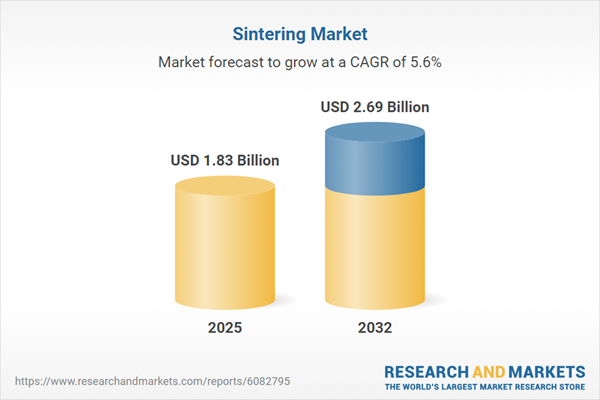Speak directly to the analyst to clarify any post sales queries you may have.
The sintering market is advancing as innovative process technologies, rising industry standards, and digital integration reshape production landscapes. Senior leaders are leveraging these trends to unlock efficiencies, boost sustainability, and gain competitive advantages throughout the manufacturing value chain.
Market Snapshot of the Sintering Market
The global sintering market is on a steady growth path, expanding from USD 1.74 billion in 2024 to USD 1.83 billion in 2025. Forecasts project a value of USD 2.69 billion by 2032, reflecting a 5.62% CAGR. This positive trend stems from rising demand for precision components in high-value industries, such as aerospace, automotive, and healthcare. Breakthroughs in powder technologies, furnace efficiency, and process digitization are positioning market participants to achieve new productivity and sustainability benchmarks. As a result, companies with agile supply chains and tailored material solutions are better equipped to capture emerging opportunities as global manufacturing standards evolve.
Scope & Segmentation
This report comprehensively examines the sintering market's span across technologies, applications, and geographies, enabling informed planning and investment decisions:
- Material: Includes ceramic powders encompassing both oxide and non-oxide ceramics, composite powders for enhanced material properties, metal powders—both ferrous and non-ferrous alloys—for strength-critical parts, and specialized polymer powders suitable for lower temperature operating environments.
- Process Type: Covers advanced and conventional sintering workflows, such as hot isostatic pressing for dense component formation, hybrid sintering for flexible production, microwave sintering for rapid energy efficiency, pressureless sintering for shape versatility, and spark plasma sintering to boost throughput and control.
- End Use Industry: Focuses on aerospace, automotive, construction, electronics, energy and power, and healthcare, each driving their own criteria for mechanical performance, dimensional stability, and process repeatability.
- Equipment Type: Encompasses batch furnaces optimizing short-run agility and continuous furnaces tailored for automated, high-volume manufacture.
- Regional Analysis: Covers the Americas—highlighting the United States, Canada, Mexico, Brazil, Argentina, Chile, Colombia, and Peru—alongside robust examination of trends in Europe, the Middle East & Africa, and Asia-Pacific markets such as China, India, Japan, Australia, South Korea, Indonesia, Thailand, Malaysia, Singapore, and Taiwan.
- Key Companies Covered: Features market leaders including GKN Powder Metallurgy, Höganäs AB, The Miba Group, Sumitomo Electric Industries Limited, Samvardhana Motherson Group, Tata Steel, Schunk Sinter Metals, ASCO Sintering Co., and Erasteel, reflecting the diverse expertise shaping industry dynamics.
Key Takeaways for Senior Decision-Makers
- New sintering techniques are enabling the creation of highly complex, material-efficient components that align with rising requirements in advanced engineering sectors.
- Digital transformation—through adoption of digital twins, advanced analytics, and machine learning—supports process optimization, predictive maintenance, and heightened operational reliability.
- Hybrid manufacturing platforms, integrating additive and sintering capabilities, are expanding design possibilities and supporting rapid prototyping to address changing customer and market demands.
- Sustainability imperatives drive the uptake of energy-efficient sintering methods like microwave and spark plasma sintering, reinforcing compliance with evolving environmental regulations.
- Shifting to regional supply strategies and strategic partnerships supports greater supply chain resilience, reducing exposure to global sourcing risks and tariff uncertainties.
- Ongoing investments in research, novel powder development, and automation technology are raising entry barriers, strengthening competitive positioning, and facilitating market differentiation.
Tariff Impact on the Sintering Market
Recent U.S. tariffs on imported raw materials and sintered products have altered procurement and manufacturing strategies for many market players. Companies are pivoting toward domestic sourcing, developing regional production hubs, and localizing powder manufacturing to counteract cost pressures and supply instability. This transition is further prompting innovations in furnace systems and driving tighter supply chain integration to minimize trade-related uncertainties while supporting market continuity.
Methodology & Data Sources
This market analysis integrates comprehensive secondary research, leveraging industry publications, regulatory documentation, and proprietary databases. Primary insights are gathered via interviews and targeted surveys with manufacturers, suppliers, engineers, and end users, followed by expert validation and triangulation to ensure the highest levels of accuracy and relevance.
The Sintering Market: Why This Report Matters
- Gain visibility into the technology shifts and supply chain innovations that support advanced manufacturing and operational resilience in the sintering market.
- Discover actionable strategies to streamline operations, navigate regulatory and tariff challenges, and fuel growth across critical end-use industries.
- Benchmark your strategic direction with industry leaders as you respond to shifting regulatory, market, and competitive dynamics.
Conclusion
The sintering market continues to realign as it integrates technology advancements, optimizes supply chains, and prioritizes sustainability. Executives who invest in robust processes, digital solutions, and regional sourcing will be well positioned to lead and capture new opportunities.
Table of Contents
3. Executive Summary
4. Market Overview
7. Cumulative Impact of Artificial Intelligence 2025
Companies Mentioned
The companies profiled in this Sintering market report include:- GKN Powder Metallurgy
- Höganäs AB
- The Miba Group
- Sumitomo Electric Industries Limited
- Samvardhana Motherson Group
- Tata Steel
- Schunk Sinter Metals
- ASCO Sintering Co.
- Erasteel
Table Information
| Report Attribute | Details |
|---|---|
| No. of Pages | 186 |
| Published | October 2025 |
| Forecast Period | 2025 - 2032 |
| Estimated Market Value ( USD | $ 1.83 Billion |
| Forecasted Market Value ( USD | $ 2.69 Billion |
| Compound Annual Growth Rate | 5.6% |
| Regions Covered | Global |
| No. of Companies Mentioned | 10 |









